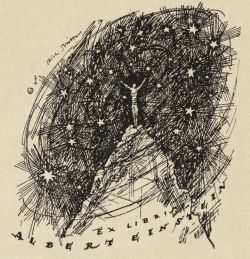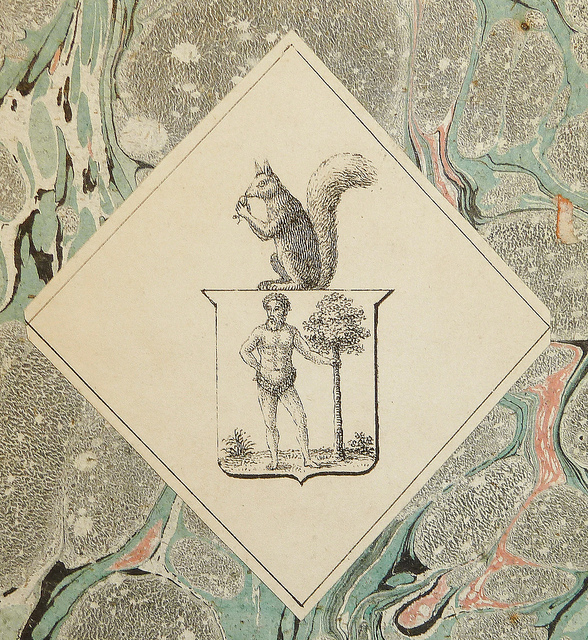Bookplates or Book Labels1 are nearly as old as printed books themselves. Going as far back as 500 years ago, bookplates, tell us interesting stories that provenance marks in historical books about books and their owners. The earliest known examples of printed bookplates are German, and date from the 15th century. Hand-colored woodcuts, pasted into books presented to the Carthusian monastery of Buxheim, by Brother Hildebrand Brandenburg of Biberach, give us examples of the earliest known bookplates. One such specimen can be found in the Farber Archives of Brandeis University.2
The term “Ex Libris” (Exlibris, in German), often found on bookplates, translates as “From the library of”, originated in France. The most ancient French ex-libris known presently is the Jean Bertaud de la Tour-Blanche, dated 1529. Even though from the middle of the century, the ex-libris proper became quite popular, the earliest known American example of a bookplate, is the plain printed label of Stephen Daye, the Massachusetts printer of the Bay Psalm Book, 1642.3
Bookplates often record the name, coat-of-arms, heraldic symbolism, family mottos or other emblematic devices of the owner. Although the majority of the older plates were armorial, sometimes pictorial images, without actual text, were used to signify particular ownership. Some of these bookplates present enigmas to curators and bibliographers who are pursuing to document a book’s provenance. The Provenance Online Project, (POP), from the Kislak Center for Special Collections, Rare Books, and Manuscripts at the University of Pennsylvania, owns an interesting bookplate.
This mysterious, squirrel and bodybuilder bookplate, affixed to an 1802 German book, Torquato Tasso’s “Nächtliche Klagen der Liebe : Ein neu entdecktes nachgelassenes Werk / aus dem Italienischen übersetzt mit einigen nöthigen erläuternden Anmerkungen und dem Leben des Verfassers,” remains puzzling. The organization is asking for your help: “Do you have any ideas about who the mystery squirrel and bodybuilder bookplate belonged to?”
In general, collectors will prefer a un-bookplated book, rather than one with a bookplate affixed to its pastedown. However, if the bookplate belonged to someone of importance, it is possible that the value of the book may be raised significantly. An example is a copy of the third edition of Isaac Newton’s, “PHILOSOPHIÆ NATURALIS PRINCIPIA MATHEMATICA.” LONDON: APUD GUIL. & JOH. INNYS, REGIÆ SOCIETATIS TYPOGRAPHOS, 1726. Despite being a third edition, the book is of course one of the greatest works in the history of science; a cornerstone on dynamics and gravitation, which in good condition can be traded for around $10,000. This particular copy, offered for sale at the Sotheby’s event – History of Science and Technology, held on December 12, 2017 in New York, had affixed to its pages, the bookplates of Albert Einstein & Roman Vishniac. The book, including the buyer’s premium, sold for $87,500. A very valuable set of labels indeed!
Unfortunately, similar to all tangible things with lucrative valuations, bookplates attract forgers. Buyers without the knowledge or the use of professional help are vulnerable to tricks of forgery. Similar to signatures, bookplates found in a valuable book may have been forged. Even if the bookplate is real, it does not reveal when the bookplate was affixed to the book under consideration. For instance, a bookplate of Charles Dickens,in a copy of Wilkie Collins’The Queen of Hearts,(1859), would be a splendid association copy. But, though the bookplate might be genuine and the book itself a first edition, the bookplate could have come from another source and been added to the book years after Dicken’s death.4
Not every collectible book will have such conspicuous associations as the example cited above. In fact, high spots with recognizable bookplates are more likely to make their way to research libraries where electronic cataloging methods are used to effectively trace provenance. The existence of such curatorial files facilitates bibliographic comparison that may offer a historic linkage. Even if no match is made, the comparison may lead to the conclusion that the two copies are not identical, and begin a new, copy-specific curatorial file and possibly the beginning point to startling revelations. Such thorough provenance research should not be limited to merely the world’s most famous books. After all, a presumption that a book with some bookplate in a contemporary library will have no significant cultural importance at some point in the future is quite speculative.
1 Bookplates are usually larger or more ornate than book labels, which tend to have just the owner’s name.
2 http://www.brandeis.edu/now/2009/august/bookplate.html
3 https://www.finebooksmagazine.com/fine_books_blog/2013/07/the-first-american-bookplate.phtml
4 Rare Book Librarianship: An Introduction and Guide Steven K. Galbraith, Geoffrey D. Smith, Joel B. Silver



{ 1 comment… read it below or add one }
The “body builder” looks a lot like the “wild Man” of Wölfenbuttel, Luneburg, Braunschweig, often portrayed on coins. They often hold a tree for a sense of scale I guess. I would start there.
Search ebay for coins and Braunschweig wild man.
Or, view the coins at https://coins.www.collectors-society.com/wcm/CoinCustomSetView.aspx?s=20282